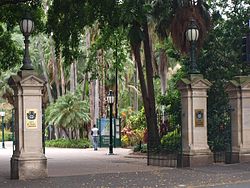| City Botanic Gardens | |
|---|---|
 City Botanic Gardens with buildings in the CBD visible in the background | |
 | |
| Type | Botanical |
| Location | Brisbane, Queensland, Australia |
| Coordinates | 27°28′29″S 153°01′48″E / 27.4747°S 153.0301°E |
| Area | 200,000 m2 (49 acres) |
| Opened | 1855 |
| Owned by | Brisbane City Council |
| Designation | State Heritage Place (Queensland Heritage Register)[1] |
| City Botanic Gardens | |
|---|---|
 Entrance gates, Albert Street, 2016 | |
| Location | 147 Alice Street, Brisbane City, City of Brisbane, Queensland, Australia |
| Coordinates | 27°28′33″S 153°01′47″E / 27.4759°S 153.0296°E |
| Design period | 1824–1841 Convict settlement |
| Official name | Brisbane Botanic Gardens, Queen's Park, Walter Hill Fountain |
| Type | state heritage (built, landscape) |
| Designated | 3 February 1997 |
| Reference no. | 600067 |
| Significant period | 1865–1920s (fabric) 1828–1855, 1855–1970s, (historical) 1855–ongoing (social) |
| Significant components | drain – storm water, gate – entrance, animal enclosure/s, garden – bed/s, tree groups – avenue of, wall/s – retaining, residential accommodation – housing, rotunda, pathway/walkway, lake / pond / waterway, tree groups – copse, fountain, steps/stairway, trees/plantings, garden/grounds, wall/s, amphitheatre |
The City Botanic Gardens (formerly the Brisbane Botanic Gardens) is a heritage-listed botanic garden on Alice Street, Brisbane City, City of Brisbane, Queensland, Australia. It was also known as Queen's Park. It is located on Gardens Point in the Brisbane CBD and is bordered by the Brisbane River, Alice Street, George Street, Parliament House and Queensland University of Technology's Gardens Point campus. It was established in 1825 as a farm for the Moreton Bay penal settlement.
The Gardens include Brisbane's most mature gardens, with many rare and unusual botanic species. In particular the Gardens feature a special collection of cycads, palms, figs and bamboo.
The City Botanic Gardens was added to the Queensland Heritage Register on 3 February 1997.[1] The Queensland Heritage Register describes the Gardens as "the most significant, non-Aboriginal cultural landscape in Queensland, having a continuous horticultural history since 1828, without any significant loss of land area or change in use over that time. It remains the premier public park and recreational facility for the capital of Queensland, which role it has performed since the early 1840s."[1]
- ^ a b c "Brisbane Botanic Gardens (entry 600067)". Queensland Heritage Register. Queensland Heritage Council. Retrieved 1 August 2014.
